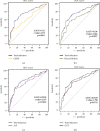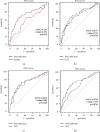The Diagnostic Value of GGT-Based Biochemical Indicators for Choledocholithiasis with Negative Imaging Results of Magnetic Resonance Cholangiopancreatography
- PMID: 35949700
- PMCID: PMC9348969
- DOI: 10.1155/2022/7737610
The Diagnostic Value of GGT-Based Biochemical Indicators for Choledocholithiasis with Negative Imaging Results of Magnetic Resonance Cholangiopancreatography
Abstract
To reveal the relationship between a group of preoperative biochemical indicators such as GGT, ALP, ALT, AST, TB, and DB and the occurrence of common bile duct stones in patients with negative results of magnetic resonance cholangiopancreatography, a retrospective diagnostic accuracy clinical test is conducted in this study. In order to reduce the missed diagnosis rate of choledocholithiasis and perform more accurate common bile duct exploration, 466 patients who underwent surgical treatment of cholelithiasis from January 2014 to December 2015 have been analyzed retrospectively. Firstly, the confounding factors are corrected through Binary Logistic regression. Then, the diagnostic efficacy of each indicator is measured by the ROC curve among different types of patients. In all patients, the top three individual indicators with the greatest AUC curve area for predicting common bile duct stones can be observed from the results of MRCP, γ-glutamyl transpeptidase, and alkaline phosphatase. Besides, the diagnostic efficiency of the comprehensive evaluation is higher than that of all individual indicators. For MRCP-negative patients, the top three largest AUC curve area of the diagnostic efficacy for choledocholithiasis were GGT, ALP, and DB. For patients who have a suspected diagnosis of secondary choledocholithiasis, the diagnostic efficacy of the combination of imaging results, biochemical indexes, common bile duct width, and other abnormal indicators for choledocholithiasis is much higher than that of the single abnormal biochemical indexes for the prediction of choledocholithiasis. For MRCP-negative patients, GGT, ALP, DB, and the width of common bile duct diameter are valuable for the prediction of common bile duct stones, and GGT is the most valuable diagnostic predictor.
Copyright © 2022 Huajun Lin et al.
Conflict of interest statement
The authors declare that they have no conflicts of interest.
Figures



Similar articles
-
Might be over-evaluated: Predicting choledocholithiasis in patients with acute biliary pancreatitis.Ulus Travma Acil Cerrahi Derg. 2025 Mar;31(3):249-258. doi: 10.14744/tjtes.2024.36114. Ulus Travma Acil Cerrahi Derg. 2025. PMID: 40052312 Free PMC article.
-
Diagnostic value of magnetic resonance cholangiopancreatography to detect bile duct stones in acute biliary pancreatitis.Pancreatology. 2018 Jan;18(1):22-28. doi: 10.1016/j.pan.2017.12.004. Epub 2017 Dec 9. Pancreatology. 2018. PMID: 29246689
-
[Accuracy of magnetic resonance cholangiopancreatography for the diagnosis of common bile duct stones].Rev Med Chil. 2008 May;136(5):600-5. Epub 2008 Jul 30. Rev Med Chil. 2008. PMID: 18769807 Spanish.
-
Utility of MRCP in clinical decision making of suspected choledocholithiasis: An institutional analysis and literature review.Am J Surg. 2017 Aug;214(2):251-255. doi: 10.1016/j.amjsurg.2016.10.025. Epub 2016 Dec 1. Am J Surg. 2017. PMID: 27986260 Review.
-
Diagnostic value of magnetic resonance cholangiopancreatography in choledocholithiasis.World J Gastroenterol. 2015 Mar 21;21(11):3351-60. doi: 10.3748/wjg.v21.i11.3351. World J Gastroenterol. 2015. PMID: 25805944 Free PMC article. Review.
Cited by
-
The Predictive Value of the Combination of Serum RBP4, ALP, IL-1β for Postoperative Recurrence of Intrahepatic Bile Duct Stones.Ther Clin Risk Manag. 2025 Aug 15;21:1277-1285. doi: 10.2147/TCRM.S529277. eCollection 2025. Ther Clin Risk Manag. 2025. PMID: 40837286 Free PMC article.
-
Toxicological Evaluation of Kaempferol and Linearolactone as Treatments for Amoebic Liver Abscess Development in Mesocricetus auratus.Int J Mol Sci. 2024 Oct 2;25(19):10633. doi: 10.3390/ijms251910633. Int J Mol Sci. 2024. PMID: 39408962 Free PMC article.
-
Might be over-evaluated: Predicting choledocholithiasis in patients with acute biliary pancreatitis.Ulus Travma Acil Cerrahi Derg. 2025 Mar;31(3):249-258. doi: 10.14744/tjtes.2024.36114. Ulus Travma Acil Cerrahi Derg. 2025. PMID: 40052312 Free PMC article.
References
-
- Kim S. Y., Kim K. H., Kim I. D., et al. The variation of hepatic duct confluence and asymptomatic common bile duct stone with routine intraoperative cholangiogram during laparoscopic cholecystectomy. Korean Journal of Gastroenterology . 2011;58(6):338–345. doi: 10.4166/kjg.2011.58.6.338. - DOI - PubMed
-
- Kim H., Shin S. P., Hwang J. W., Lee J. W. Outcomes of laparoscopic common bile duct exploration (LCBDE) after failed endoscopic retrograde cholangiopancreatography versus primary LCBDE for managing cholecystocholedocholithiasis. Journal of International Medical Research . 2020;48(10) doi: 10.1177/0300060520957560.030006052095756 - DOI - PMC - PubMed
Publication types
MeSH terms
LinkOut - more resources
Full Text Sources
Miscellaneous
